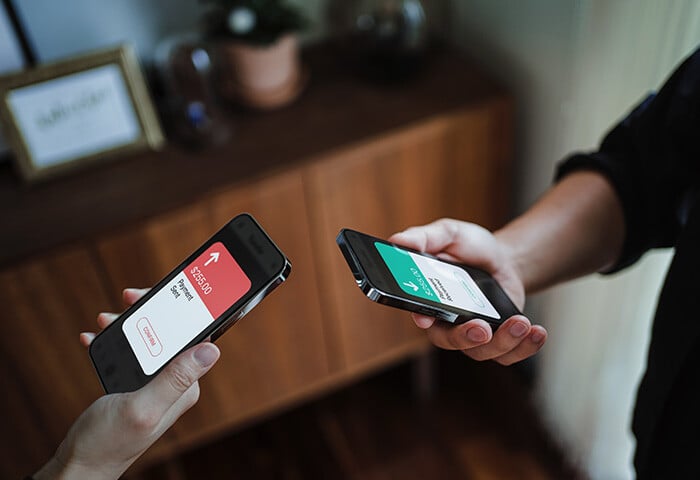What are fake text messages?
Fake text messages are unwanted SMS messages often used by scammers to trick you into providing money or personal information. Fake texts can be part of SMS phishing scams (also known as smishing) that can infect your phone with malware or spyware, putting you at risk of fraud and identity theft.
Because almost everyone owns a mobile phone, SMS scams are a huge market for fraudsters to exploit with fake text messages to try to catch unsuspecting victims. In fact, it’s highly likely that you’ve received at least one fake text message already. And according to the Federal Trade Commission (FTC), around $330 million was reported lost in scams originating from fake texts in 2022.
Here are some examples of the types of fake text messages commonly used by scammers:
-
Promotions for free gift cards, prizes, or cash
-
Fake Netflix verification texts
-
Offers that are too good to be true
-
Requests for banking details to verify a fake transaction
-
Messages promising to help pay off loans or debts
How to identify a fake text message
Despite scammers using different types of fake text messages, there are common signs you can look out for. To identify a scam text, pay attention to the sender’s name and contact info, and look closely at the content of the message. Scammers often lie about money you’re owed, fake prizes you’ve won, or even an urgent package you know nothing about.
Whether the message arrives via SMS text message, dedicated messaging app, or another social app, here’s how to identify a fake text:
1. The message is not relevant to you
Fraudsters write generic, automated messages and send them to thousands of phone numbers hoping that someone takes the bait. For example, a notification about a package delivery you’re not expecting, or an offer to buy something you’re not selling are both indicators that the message is fake. Texts that seem irrelevant to you should raise a big red flag — it’s likely a scam.
In the fake text message below, the scammer is trying to sound more legitimate by referring to a specific item. But, this specific item is not for sale and the screenshot they provided is very general. This text should also ring alarm bells because the sender is asking for personal details. Remember that scammers usually try to collect your private data or your money.

2. The message contains long phone numbers
Most legitimate US phone numbers are either ten digits long or a shortcode. So if the message has come from a number longer than this, it may be a scam from a fake number. Of course, there are times when long phone numbers aren’t an indicator of suspicion, such as international numbers. But if you’re not expecting to receive a message from an international number then this could be a fake text message.
In this example of a fake text message, the phone number is 13 digits long, likely indicating a scam.

3. The message contains grammatical errors
You can tell if a text is fake when there are obvious grammatical or spelling errors. Legitimate companies can of course make occasional mistakes, but fake texts are often riddled with typos, incorrect punctuation, or strangely-phrased sentences. If you spot anything like this, and the message is from an unknown person, it's a good indication the message is fake.
The example below is commonly what fake text messages look like.

4. The text message promises a gift after clicking a link
A telltale sign of a fake message is when it contains a suspicious link. At first glance, a link may look legitimate, especially if it claims to be from a big brand or company you trust. Verify a URL via your browser, then compare it to the one in the text message you’ve received. If the linked URL in the message looks different, it’s probably a scam.
Clicking unsafe links from fake text messages can download malware that could hijack your phone or spy on your activity. A suspicious link could also lead you to a pharming website created to collect personal data. Avoid clicking suspicious links, especially when they come from a number you don’t recognize.
Take a look at the fake text message below that tries to entice you to click a suspicious-looking link to claim a fake gift card. If you clicked that link, your “prize” could be a virus.

5. The message requires urgent action
A message that asks for urgent action is another common sign to look out for when detecting fake text messages. Fraudsters play on human emotions to get you to react and divulge the information they’re after. But don’t fall for scammers’ fake text alerts. Always verify the problem independently, whether that’s by phone, online, in person, or email.
Here are some examples of fake messages requesting urgent action:
-
A close friend or family member is in trouble and needs your immediate help.
-
The IRS is looking for a missing payment.
-
A trusted brand is asking you to add missing details to your account.
-
An order confirmation is needed within a short timeframe.
The fake text message below may look real, but the scammer is using a pretext to try to trick you into urgent action by claiming that you’ll incur costs if you don’t click the link immediately.

6. The message is from a financial institution
Scammers have no qualms about spoofing a bank, financial institution, or the IRS. Even if the message looks real, verify the content by calling or visiting the relevant institution. If the message isn’t from a bank where you hold an account, remember the first rule for detecting a fake text message: if the message is not relevant to you, it’s probably a scam.
The following text message may look legitimate, but the IRS will not send texts about your tax refund.

How to handle a fake text message
Never reply or click any links in a fake text. It’s best to ignore the text and block the sender’s number. You may also choose to report the fake texts to your mobile service provider to help prevent others from being targeted by the same scammer. And use only the most secure messaging apps when communicating with family and friends.
Do not respond immediately or click links
Don’t even respond with “STOP” or “NO,” if the text message looks even a little suspicious. You don’t want to give the scammer any indication that your phone number is real, or you may become the target of even more fake text messages.
The goal of any fake text message is to get you to respond. But if you click a strange link or reply, you could end up with malware or inadvertently giving away too much personal information. If a person you know sent a message that seems strange, their device might've been hacked. Verify if the message is legitimate by contacting the sender another way.
Block the number
Sometimes scammers are persistent and send multiple messages in the hope of annoying you into responding. If this happens, block the scammer's number.
Here’s how to block a number on an iPhone:
-
Open the fake text, select the profile icon at the top of the message, and tap the Info icon.

-
Select Block this Caller, then tap Block Contact.

The scammer’s number is now blocked.
Here’s how to block a number on an Android phone:
-
Open the fake text, tap the Menu (three-dots icon), and select Details.

-
Select Block & report spam. Tap the box next to Report spam to notify Google and your carrier, then tap OK.

The scammer can no longer text your Android phone from this number.
Report the fake text to the FTC
The Federal Trade Commission (FTC) has a dedicated website for consumers to report fraud. Select the category that the message fits into, fill in the form, then paste the content of the fake text message into the comments field of your report — but don’t click any links in the text message when doing this.
Reporting suspected fake text messages from people who might be trying to scam you can help law enforcement identify patterns across geographical areas.
Report the fake text to your mobile service provider
As a final step, you can report the scam by forwarding the fake text message to 7726 (SPAM). This alerts your phone service provider so they can investigate the origin of the text message and block or ban the sender if it's found to be malicious.
Avoid fake text messages with AVG
Whenever you receive a text message from an unknown number, it’s always best to be cautious and avoid responding or clicking links. But accidents can happen. To give yourself more peace of mind, install AVG AntiVirus, which can help protect your device from viruses and other malware that can hide in fake texts.
Protect your device from malware, phishing links, and dangerous websites. Install AVG AntiVirus today — completely free.
FAQs
What happens if you click on a fake text message?
Clicking on a link or opening an attachment in a fake text message could expose your personal data or install malware onto your device, such as viruses, spyware, or ransomware. Once that happens, scammers could hack your phone and even spy on what you type — whether it’s a text, email, or login details when signing into an online account.
Can someone fake a text message?
Yes, if you’re even just a little bit tech savvy it’s possible to alter or fake a text message. These days, there are apps and software available specifically for scammers to mock up real-looking text messages meant to scam people.
Why am I suddenly getting fake text messages?
Your number may have ended up in a scammer’s database, or it could have been generated randomly. If you’re suddenly receiving an onslaught of fake text messages, be extra vigilant — it could mean that someone now has your phone number and is trying to steal your personal information, such as banking info and account login details.
.png)
.png)

























